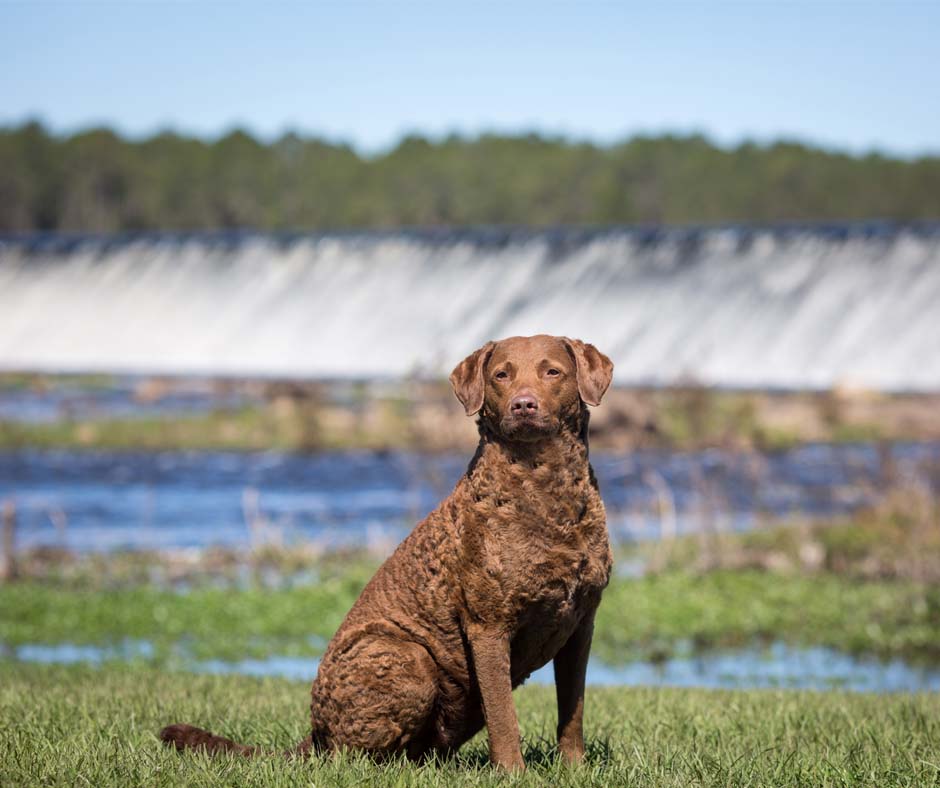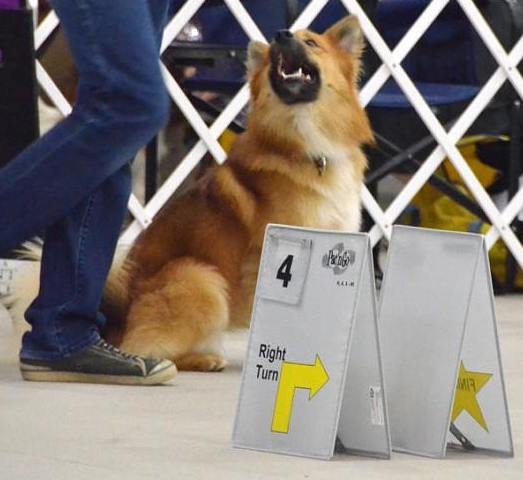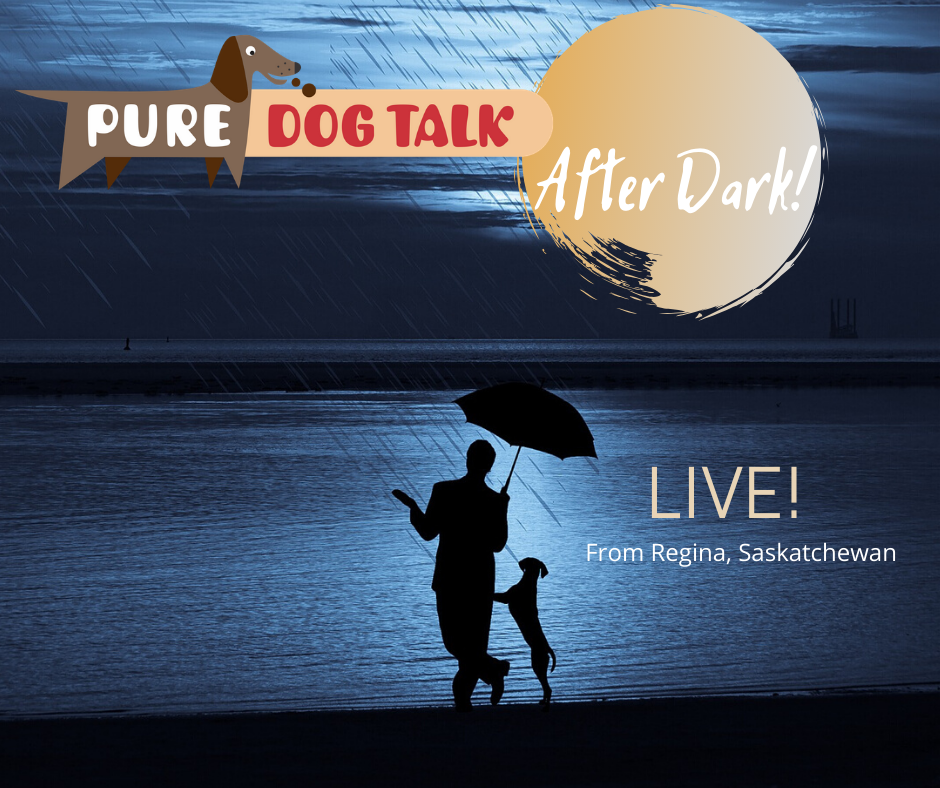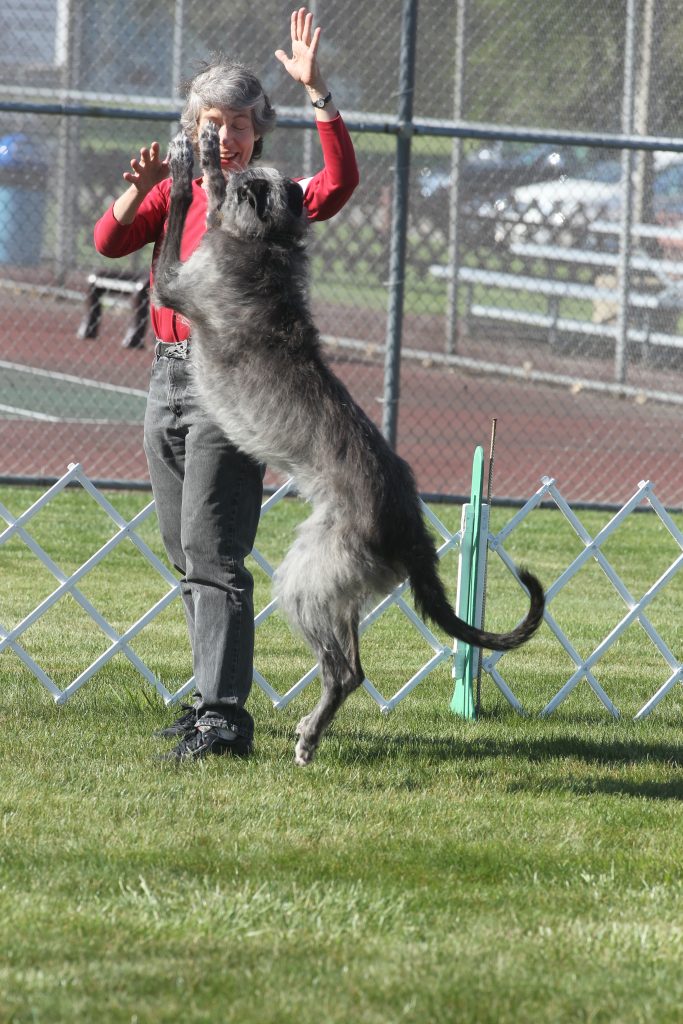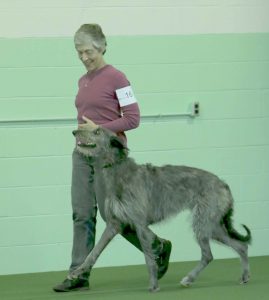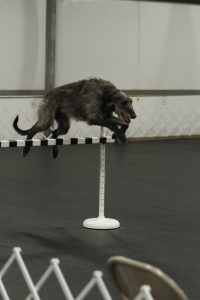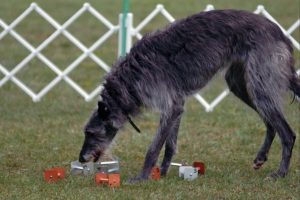514 – Chesapeake Bay Retrievers: An American Success Story
Chesapeake Bay Retrievers: An American Success Story
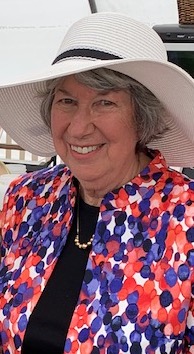 Betsy Horn Humer has spent a lifetime with Chesapeake Bay Retrievers. Her parents acquired their first dog in 1947 and Betsy has been deeply involved in the breed since childhood. A conformation and obedience/rally judge, Betsy brings tremendous depth and width of experience to her understanding of the sport.
Betsy Horn Humer has spent a lifetime with Chesapeake Bay Retrievers. Her parents acquired their first dog in 1947 and Betsy has been deeply involved in the breed since childhood. A conformation and obedience/rally judge, Betsy brings tremendous depth and width of experience to her understanding of the sport.
“They’re very different from the other retrievers,” Betsy said. “They’re not like Goldens and Labs who love everybody and wanna be your friend. They’re much more reserved. They’re much more like some of the working breeds — German Shepherds and Dobermans, Rottweilers.
“They have a real work ethic and they’re serious. They’re much more serious than your average Golden and Labrador. They’re not the dog for everyone, especially a first dog.
 “They’re very protective and that’s really because of their heritage and why they were originally developed.
“They’re very protective and that’s really because of their heritage and why they were originally developed.
“They were originally developed on Chesapeake Bay, of course. The story is that there was a shipwreck. There were a couple of dogs on the ship and they swam to the shores. One was named Sailor and one was named Canton. They were not Chesapeakes but they were more like the Saint John’s dog. The Labrador also goes back to that particular breed.
“They were bred with a couple of the other local hunting dogs and some of the background includes setters and bloodhounds and other retrievers. It’s an interesting mix and it does explain why we do have different types of coats and different kinds of hound markings because of the genetics that’s actually behind the breed.

2021 National Specialty show- Award of Merit. GCHB Eastern Waters’ Pink Power O’MesaRidge, BN RI. Owners/ Breeders – Betsy Horn Humer & Rupert J. Humer
“The breed was really developed and records were kept by the wealthy land owners who owned property on the Chesapeake Bay and had huge hunting clubs. It was the local marketers, the duck hunters and the water fowlers that used them for hunting back in the late 1800s.
“There were no limits on how many ducks you could take and these hunters would take several hundred a day. The Chesapeake would just go out in the Bay and retrieve them all, that was his job. When he wasn’t actually swimming and retrieving, his job was to guard the pile of ducks so that nobody else would take them. These ducks were sold to expensive restaurants in Baltimore. They were considered a real treat.
“Winters were much colder then. There was ice to be broken. The Chesapeake Bay is huge. I mean you’re not talking just like a little lake it is huge. You get tremendous amounts of tides, wind. It can be a very unpleasant place during hunting season. But these hunters, that was how they made their living and that was what they did.
“(Chesapeakes) are very strong. They’re much stronger than they look. They’ve got very strong bone. Their coat was developed in order to keep them warm. They have what’s referred to as a double coat. There’s a very soft undercoat and it’s interesting because it’s all one hair. The tops of the hair are very coarse and wiry but as you get closer to the skin, the coat is actually very soft and the outside harshness keeps the inside, the other part of it, dry.”
Be sure to listen in to this wide ranging conversation for more insights on the Chesapeake, judging in the show ring and the obedience ring, dog breeding and more.
403 – Virtual Reality: Step by Step to a Rally Title for Your Dog
Virtual Reality: Step by Step to a Rally Title for Your Dog
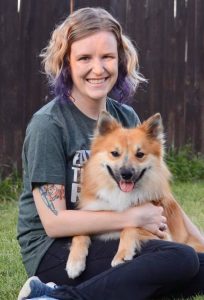 Trainer Gabi Vannini from What A Great Dog! walks us through the process to earn a virtual rally title for your dog. Below is a short excerpt from our conversation. Listen in to the podcast for excellent training tips, rally performance do’s and don’ts and more.
Trainer Gabi Vannini from What A Great Dog! walks us through the process to earn a virtual rally title for your dog. Below is a short excerpt from our conversation. Listen in to the podcast for excellent training tips, rally performance do’s and don’ts and more.
“You can submit videos for your rally novice title,” Vannini said. “So the entry level rally, you can submit three videos and get an actual rally title. It’s the same as if you went to a trial. You would have to get three qualifying legs. They’re having judges actually score these runs and look at them, so it’s not just a pass/fail. You’re actually getting your score out of 100 on that and having to do it just like you would in a trial. They’ve got five different courses that you can pick from to try out. They’ve set courses for you and you can do it in your backyard or your local park. If you have a local training building that you can rent the ring out, I know that’s what a lot of people have been doing, but you can get creative with it. Wherever you can fit a reasonably sized rally course and either set up a tripod or get someone to video for you and submit to AKC and get your actual rally novice title.
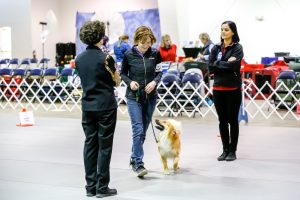 “(AKC has) been really helpful with … the rally maps. (They) have a specific spot on the map, ‘place camera here’ so that they can get the best view for the judges to be able to look at it. They’ve got the maps laid out for you. All five maps that you can pull up and use. They’ve got a really simple way to submit everything. They got their instructions and all of that right there. They’ve got a nice little how to perform the rally sign setup for you, so it’s really making it very accessible for people who are wanting to try something different with their dog.
“(AKC has) been really helpful with … the rally maps. (They) have a specific spot on the map, ‘place camera here’ so that they can get the best view for the judges to be able to look at it. They’ve got the maps laid out for you. All five maps that you can pull up and use. They’ve got a really simple way to submit everything. They got their instructions and all of that right there. They’ve got a nice little how to perform the rally sign setup for you, so it’s really making it very accessible for people who are wanting to try something different with their dog.
“I think this is going to be a really good opportunity. For people that know rally and do rally, you can fly through these if you want to. But I think it’s a really nice thing for people that maybe have done some of those trick titles or CGC … and now they have something a little more that they can learn about and do at home. By the time we get rolling back in dog shows, maybe they’ll want to jump up and go into rally intermediate, where it’s similar signs and are still on leash and see how things go.
“You always are gonna get the people that are gonna say that it’s gonna cheapen their rally title that they got. All things change. I got an Open title with my dog and no where does it say on my title certificate that he did the long stay in a group. Just because somebody can go do a virtual rally, it doesn’t mean yours is less. Those people aren’t competing with you. If you’re real serious about your rally and you want to get like 100 points on everything, wait for a dog show. The people who are being brought in by this rally virtual program, they’re not your competition. You don’t need to look at them as some kind of threat.”
370 – How Judges Decide Placements: Conformation and Obedience
How Judges Decide Placements: Conformation and Obedience
Part two of our panel discussion at the Regina Kennel and Obedience Club’s Prairie Christmas Dog Show with an international coterie of judges focuses on: the details of breed type and presentation, exercising patience, judging uncropped and undocked dogs, legislation and growing our sport.
From Sue-Ellyn Rempel on making a final placement:
“I guess for me general outline for starters and then movement is very breed specific for me. So I kind of go by that…. they have to scream German Shepherd … a lot of times we get … a class of 5 and they’re all generic … they get from point A to point B really well they stack and their moderately angulated like the breed should be but they’re not smooth, they don’t flow in the correct way…. like the make and shape difference in the shape from a Great Dane to a whippet… whippets you want the beautiful soft gentle curves… that’s gotta hit me right away… when I look at them, that they are the right shape and then when they take the steps, that puts the picture together for me.”
From Frances Smith on what she sees in the ring:
“I find it very important to reward the breed specific, unique characteristics because (there are) a lot of generic dogs, too many generic dogs, too many dogs that finished championships that really… shouldn’t be … because supposedly a champion is a superior specimen of the breed. So it’s up to us to keep the quality and to reward those breed specific points because without them we lose those identifying points of each breed. I want to add another thing that’s very important, temperament, which is also one of the 6 points in type, … because the temperament has to belong to the breed …without the correct temperament I don’t care if a dog is extremely showy, he’s gotta have the breed’s temperament. I don’t want just a fancy dancer in the ring … I don’t want to see a dog jumping and doing things that aren’t typical of his breed.”
From Diana McKenzie on changes she’s seen in her time in the sport:
“There’s been a ton of changes over the years in obedience … even training methods OK these days are so different from what they were 20-30 years ago. … unfortunately a lot of people go into obedience and they think it’s easy. OK rally is easy, yes. Obedience is not easy. It is not a given and it’s something that you as a handler have to work with your dog to attain a nice working relationship with and train the behaviors. Rally is easy to me, I shouldn’t say it’s easy to everyone, but it’s a wonderful venue to train with your dog and teach your dog in a positive way how to move its rear end and be aware of its rear end movement which a lot of people don’t do. (That’s) just one small thing that you can think of to work with them. Fronts, finishes, drops, all of that are in rally obedience as well as the heeling, so when you see a team in rally obedience and they are true team it’s wonderful. … in obedience … over the years training methods are changing. Corrections, harsh corrections, are becoming less and less used (people are) more into the purely positive methods. That’s wonderful, if you know how to do it properly. A lot of people don’t, therefore they get a brat in a dog that goes in (and says) “I don’t have to ’cause there are no consequences…”
213 – Scottish Deerhounds in Obedience with Record-Making Trainer
Training Scottish Deerhounds for obedience competition requires patience
The “otherworldly” grace of Scottish Deerhounds first appealed to Debbie Cutter in the early ‘80s as she sought a dog to compete in obedience. Her original breeder told her “do not try to do obedience with deerhounds. They aren’t good at it and they don’t like it.”
In the intervening 35 years, Cutter has finished eight UD titled Scottish Deerhounds, including the first and only two UDX deerhounds.
While there has never been an Obedience Trial Champion (OTCH) Deerhound, Cutter’s current competition dog is well started on her way, “God, I’m hoping,” Cutter said. “That’s my goal. She has 6 OTCH points and her open B first place.”
“The basic essential for training obedience with Deerhounds is to be more stubborn than the dogs,” Cutter added.
Make it their idea
Her secret to success working with an independent breed that is specifically designed to *not* be biddable: make them think everything is their idea.
“Deerhounds will teach you that they can’t do obedience,” Cutter laughed. “Any time you try to impose your will on a deerhound, the dog just says no. You are not going to make me do this and I’ll embarrass you until you quit. They don’t want people to have expectations. Because once the owner starts having expectations that the dog is required to meet, they won’t be able to live their life of luxury.”
Make it FUN
Cutter’s best recommendation is to start young and convince the puppy that obedience is a fun activity. She works primarily with bitches, she said, as the males aren’t as mentally tough. “Teach her that she is in control. She is in charge of dispensing treats. Once they learn that, they see what else they can make you do.”
- Make them think their idea
- Break all exercises into small steps
- Build teamwork after you get buy-in
Deerhounds are very smart, Cutter said, they aren’t easily distracted and they generalize well, but they are not at all biddable. A Deerhound’s first reaction is, “I know what you want me to do, I just don’t care.”
Fair and Patient
“They want to know what’s in it for me,” Cutter said. “They do a risk:benefit analysis on everything.”
“I’m a balanced trainer,” Cutter said. “(Deerhounds) are very rules oriented. You don’t really have a leadership role, it’s fully a negotiated relationship.
“For example, Sighthounds have no genetic desire for a retrieve. It takes a long time. It’s not a casual thing to teach a Deerhound to retrieve. You need to be very fair and patient.”
Listen to today’s episode to hear more training tips and Cutter’s fabulous story about her recent trip to the AKC Obedience Championship.
Debbie Cutter Biography:
I’ve been doing obedience training for 35 years.
My first dog was a German Shepherd; she earned a UD and a TD, and my second dog was my first Deerhound, Scarlet (Fairyfort’s Study in Scarlet UDTX FCH). She was the second Deerhound to earn a UD (Utility Dog) title and the first to earn a TDX (Tracking Dog Excellent) title. I’ve not been without a Deerhound since, although I’ve had some other breeds along the way.
My next Deerhound was Lacey (CH Kyleakin Cardinal at Skyhigh UD TD), then came Caitlyn (CH Highlander Annwn O’Jubalhil VCD2 UDX VC), the breed’s first VCD2 (an AKC versatility title that combines the CDX, TD, OA, and OAJ titles) and the breed’s first UDX (Utility Dog Excellent, which requires earning ten legs by qualifying in both Utility B and Open B at the same trial). This was a very challenging title for us as I really didn’t know if we had the endurance to complete it! Caitlyn was nine when she got her last leg. It was one of my happiest moments in the obedience ring!
Caitlyn had one litter, with Ellen Bonacarti’s Rory (NFC BII DC Chartwell Silver Run Valevue LCM6 SGRC GRC FCH) and from that litter I had Kit (Skyhigh Spitfire O’Jubalhil UD FCH GRC) and Ariel (CH Skyhigh Citabria O’Jubalhil VCD3 UDX SC MX MXJ FCH GRC VCM). Ariel was the most amazing dog I’ve ever known. She excelled in obedience, tracking, and agility, and loved LGRA most of all. She learned to cheat early in lure coursing and almost always caught the bunny. She accomplished everything I asked of her and did it with her own style. She was much smarter than I was, and much, much wiser. She was my most demanding teacher and I treasure the years I had with her.
Ariel had one litter, sired by Intl. CH Intl. FCH Nelungaloo Shadrach. I ended up with two of these offspring, Harper (Skyhigh Kentucky Thunder VCD1 UD OAJ), and Zoe (CH Skyhigh Jubalhil Blue Moon O’Dark Corner VDC2 UD). While Zoe was still alive and doing well on three legs, I acquired Rowan, who is the most talented Deerhound I’ve ever trained in obedience. I’m hoping we have many, many fun and exciting years ahead of us competing in the obedience ring.
Rowan is my eighth UD Deerhound and is close to her UDX. I’ve also earned a UDX on a German Wirehaired Pointer and UDs on two German Shepherds, two Wirehaired Pointing Griffons, another German Wirehaired Pointer, and a CDX on a rescue German Shorthaired Pointer. I’ve earned tracking titles and a handful of agility titles on these other dogs as well. I’m also currently working on a CDX on my Deerhound boy Khamsin (GCH Kyleakin Whirlwind at Skyhigh BN JC CD).

